| Listing 1 - 6 of 6 |
Sort by
|
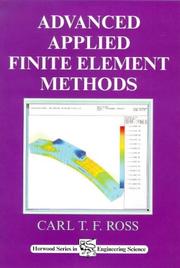
ISBN: 0857099752 1898563519 9780857099754 9781898563518 Year: 1998 Publisher: Chichester
Abstract | Keywords | Export | Availability | Bookmark
 Loading...
Loading...Choose an application
- Reference Manager
- EndNote
- RefWorks (Direct export to RefWorks)
This book is aimed at senior undergraduates, graduates and engineers. It fills the gap between the numerous textbooks on traditional Applied Mechanics and postgraduate books on Finite Element Methods.Fills the gap between the applied mechanics and finite element methodsDiscusses basic structural concepts and energy theorems, the discrete system, in-plane quadrilateral elements, field problems and mathematical modelling, among other topicsAimed at senior undergraduates, graduates and engineers
Finite element method. --- Engineering mathematics. --- Engineering --- Engineering analysis --- Mathematical analysis --- FEA (Numerical analysis) --- FEM (Numerical analysis) --- Finite element analysis --- Numerical analysis --- Isogeometric analysis --- Mathematics

ISBN: 0780334256 0198504799 0470544651 9780470544655 9780780334250 Year: 1998 Publisher: New York (N.Y.) : IEEE press,
Abstract | Keywords | Export | Availability | Bookmark
 Loading...
Loading...Choose an application
- Reference Manager
- EndNote
- RefWorks (Direct export to RefWorks)
Employed in a large number of commercial electromagnetic simulation packages, the finite element method is one of the most popular and well-established numerical techniques in engineering. This book covers the theory, development, implementation, and application of the finite element method and its hybrid versions to electromagnetics. FINITE ELEMENT METHOD FOR ELECTROMAGNETICS begins with a step-by-step textbook presentation of the finite method and its variations then goes on to provide up-to-date coverage of three dimensional formulations and modern applications to open and closed domain problems. Worked out examples are included to aid the reader with the fine features of the method and the implementation of its hybridization with other techniques for a robust simulation of large scale radiation and scattering. The crucial treatment of local boundary conditions is carefully worked out in several stages in the book. Sponsored by: IEEE Antennas and Propagation Society.
Finite element method. --- Electromagnetism. --- Engineering mathematics. --- Electromagnetic fields --- Finite element method --- Antennas (Electronics) --- Microwave circuits --- Electrons --- Electrical & Computer Engineering --- Engineering & Applied Sciences --- Electrical Engineering --- Mathematical models --- Scattering --- Microwave circuits. --- Champs électromagnétiques --- Méthode des éléments finis --- Antennes (Electronique) --- Circuits pour micro-ondes --- Mathematical models. --- Scattering. --- Modèles mathématiques --- Antennas (Electronics). --- 517.96 --- 517.96 Finite differences. Functional and integral equations --- Finite differences. Functional and integral equations --- Circuits, Microwave --- Electronic circuits --- Microwave devices --- FEA (Numerical analysis) --- FEM (Numerical analysis) --- Finite element analysis --- Numerical analysis --- Isogeometric analysis --- Electron-positron scattering --- Electron scattering --- Scattering (Physics) --- Electronic apparatus and appliances --- Electromagnetic fields - Mathematical models. --- Electrons - Scattering.
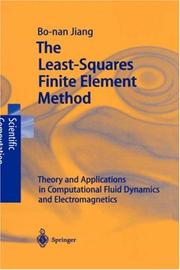
ISBN: 3540639349 3642083676 3662037408 Year: 1998 Publisher: Heidelberg : Springer,
Abstract | Keywords | Export | Availability | Bookmark
 Loading...
Loading...Choose an application
- Reference Manager
- EndNote
- RefWorks (Direct export to RefWorks)
This is the first book devoted to the least-squares finite element method (LSFEM), which is a simple, efficient and robust technique for the numerical solution of partial differential equations. The book demonstrates that the LSFEM can solve a broad range of problems in fluid dynamics and electromagnetics with only one mathematical/computational formulation. The book shows that commonly adopted special treatments in computational fluid dynamics and computational electromagnetics, such as upwinding, numerical dissipation, staggered grid, non-equal-order elements, operator splitting and preconditioning, edge elements, vector potential, and so on, are unnecessary. This book introduces the basic theory of the least-squares method for first-order PDE systems, particularly the div-curl system and the div-curl-grad system. It is applied to the study of permissible boundary conditions for the incompressible Navier--Stokes equations, to show that the divergence equations in the Maxwell equations are not redundant, and to derive equivalent second-order versions of the Navier--Stokes equations and the Maxwell equations. This book covers diverse applications such as incompressible viscous flows, rotational inviscid flows, low- or high-Mach-number compressible flows, two-fluid flows, convective flows, and scattering waves.
Mathematical statistics --- Differential equations, Partial --- -Electromagnetism --- -Finite element method --- Fluid mechanics --- -Least squares --- 519.6 --- 681.3 *G18 --- Method of least squares --- Squares, Least --- Curve fitting --- Geodesy --- Mathematics --- Probabilities --- Triangulation --- Hydromechanics --- Continuum mechanics --- FEA (Numerical analysis) --- FEM (Numerical analysis) --- Finite element analysis --- Numerical analysis --- Isogeometric analysis --- Electromagnetics --- Magnetic induction --- Magnetism --- Metamaterials --- Partial differential equations --- Numerical solutions --- Computational mathematics. Numerical analysis. Computer programming --- Partial differential equations: difference methods; elliptic equations; finite element methods; hyperbolic equations; method of lines; parabolic equations (Numerical analysis) --- Electromagnetism --- Finite element method. --- Least squares. --- Numerical solutions. --- Mathematics. --- 681.3 *G18 Partial differential equations: difference methods; elliptic equations; finite element methods; hyperbolic equations; method of lines; parabolic equations (Numerical analysis) --- 519.6 Computational mathematics. Numerical analysis. Computer programming --- Physics. --- Continuum physics. --- Optics. --- Electrodynamics. --- Calculus of variations. --- Computer mathematics. --- Fluids. --- Numerical and Computational Physics, Simulation. --- Classical and Continuum Physics. --- Classical Electrodynamics. --- Calculus of Variations and Optimal Control; Optimization. --- Computational Science and Engineering. --- Fluid- and Aerodynamics. --- Hydraulics --- Mechanics --- Physics --- Hydrostatics --- Permeability --- Computer mathematics --- Electronic data processing --- Isoperimetrical problems --- Variations, Calculus of --- Maxima and minima --- Dynamics --- Light --- Classical field theory --- Continuum physics --- Natural philosophy --- Philosophy, Natural --- Physical sciences
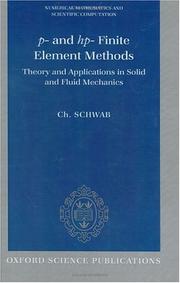
ISBN: 0198503903 Year: 1998 Publisher: Oxford : Clarendon press,
Abstract | Keywords | Export | Availability | Bookmark
 Loading...
Loading...Choose an application
- Reference Manager
- EndNote
- RefWorks (Direct export to RefWorks)
Solids --- -Fluid dynamics --- -Finite element method --- Differential equations --- -519.6 --- 681.3 *G18 --- 681.3*G17 --- Equations, Differential --- Bessel functions --- Calculus --- FEA (Numerical analysis) --- FEM (Numerical analysis) --- Finite element analysis --- Numerical analysis --- Isogeometric analysis --- Dynamics --- Fluid mechanics --- Solid state physics --- Transparent solids --- Mathematics --- Numerical solutions --- Computational mathematics. Numerical analysis. Computer programming --- Partial differential equations: difference methods; elliptic equations; finite element methods; hyperbolic equations; method of lines; parabolic equations (Numerical analysis) --- Ordinary differential equations: boundary value problems; convergence and stability; error analysis; initial value problems; multistep methods; single step methods; stiff equations (Numerical analysis) --- Finite element method. --- Fluid dynamics --- Numerical solutions. --- Mathematics. --- 681.3*G17 Ordinary differential equations: boundary value problems; convergence and stability; error analysis; initial value problems; multistep methods; single step methods; stiff equations (Numerical analysis) --- 681.3 *G18 Partial differential equations: difference methods; elliptic equations; finite element methods; hyperbolic equations; method of lines; parabolic equations (Numerical analysis) --- 519.6 Computational mathematics. Numerical analysis. Computer programming --- 517.91 Differential equations --- Finite element method --- 519.6 --- 517.91 --- Numerical solutions&delete&
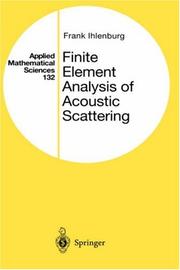
ISBN: 0387983198 9786610010172 1280010177 0387227008 9780387983196 Year: 1998 Volume: 132 Publisher: New York (N.Y.) : Springer,
Abstract | Keywords | Export | Availability | Bookmark
 Loading...
Loading...Choose an application
- Reference Manager
- EndNote
- RefWorks (Direct export to RefWorks)
Wave equation --- Scattering (Physics) --- Helmholtz equation --- Boundary value problems --- Finite element method --- Mathematical models --- Numerical solutions --- Finite element method. --- Wave equation. --- Numerical solutions. --- Mathematical models. --- -Helmholtz equation --- -Boundary value problems --- -Finite element method --- 681.3 *G18 --- 681.3 *G18 Partial differential equations: difference methods elliptic equations finite element methods hyperbolic equations method of lines parabolic equations (Numerical analysis) --- Partial differential equations: difference methods elliptic equations finite element methods hyperbolic equations method of lines parabolic equations (Numerical analysis) --- FEA (Numerical analysis) --- FEM (Numerical analysis) --- Finite element analysis --- Boundary conditions (Differential equations) --- Reduced wave equation --- Wave equation, Reduced --- Atomic scattering --- Atoms --- Nuclear scattering --- Particles (Nuclear physics) --- Scattering of particles --- Wave scattering --- Scattering --- Boundary value problems -- Numerical solutions. --- Helmholtz equation -- Numerical solutions. --- Scattering (Physics) -- Mathematical models. --- Mathematics. --- Computer science --- Mathematical analysis. --- Analysis (Mathematics). --- Numerical analysis. --- Computational intelligence. --- Analysis. --- Numerical Analysis. --- Mathematics of Computing. --- Computational Intelligence. --- 681.3 *G18 Partial differential equations: difference methods; elliptic equations; finite element methods; hyperbolic equations; method of lines; parabolic equations (Numerical analysis) --- Partial differential equations: difference methods; elliptic equations; finite element methods; hyperbolic equations; method of lines; parabolic equations (Numerical analysis) --- Differential equations, Partial --- Wave-motion, Theory of --- Numerical analysis --- Isogeometric analysis --- Collisions (Nuclear physics) --- Particles --- Collisions (Physics) --- Global analysis (Mathematics). --- Computer science. --- Engineering. --- Computer science—Mathematics. --- Intelligence, Computational --- Artificial intelligence --- Soft computing --- Mathematical analysis --- 517.1 Mathematical analysis --- Scattering (Physics) - Mathematical models --- Helmholtz equation - Numerical solutions --- Boundary value problems - Numerical solutions
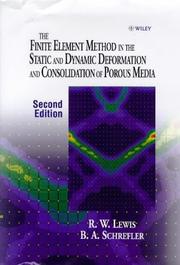
ISBN: 0471928097 9780471928096 Year: 1998 Publisher: Chichester : Wiley,
Abstract | Keywords | Export | Availability | Bookmark
 Loading...
Loading...Choose an application
- Reference Manager
- EndNote
- RefWorks (Direct export to RefWorks)
624.131.5 --- 624.159.1 --- 664 --- Porous materials --- -Finite element method --- Multiphase flow --- -681.3 *G18 --- 681.3 *G18 Partial differential equations: difference methods elliptic equations finite element methods hyperbolic equations method of lines parabolic equations (Numerical analysis) --- Partial differential equations: difference methods elliptic equations finite element methods hyperbolic equations method of lines parabolic equations (Numerical analysis) --- Flow, Multi-phase --- Flow, Multicomponent --- Flow, Multiphase --- Flow, Polyphase --- Multi-phase flow --- Multicomponent flow --- Polyphase flow --- Fluid dynamics --- FEA (Numerical analysis) --- FEM (Numerical analysis) --- Finite element analysis --- Numerical analysis --- Isogeometric analysis --- Porous media --- Materials --- Porosity --- 664 Production and preservation of solid foodstuffs --- Production and preservation of solid foodstuffs --- 624.159.1 Special foundations. Foundations for dynamic loads, resistant to earth tremors, subsidence etc. --- Special foundations. Foundations for dynamic loads, resistant to earth tremors, subsidence etc. --- 624.131.5 Soil statics. Soil dynamics --- Soil statics. Soil dynamics --- Mathematical models --- Matériaux poreux --- Matériaux poreux --- Finite element method --- 681.3 *G18 --- 681.3 *G18 Partial differential equations: difference methods; elliptic equations; finite element methods; hyperbolic equations; method of lines; parabolic equations (Numerical analysis) --- Partial differential equations: difference methods; elliptic equations; finite element methods; hyperbolic equations; method of lines; parabolic equations (Numerical analysis) --- Special foundations. Foundations for dynamic loads, resistant to earth tremors, subsidence etc --- Finite element method. --- Mathematical models. --- Méthode des éléments finis --- Ecoulement polyphasique --- Modèles mathématiques --- Éléments finis, Méthode des --- Analyse numérique --- Analyse numérique --- Éléments finis, Méthode des. --- Dynamique --- Statique --- Consolidation --- Deformation --- Milieu poreux
| Listing 1 - 6 of 6 |
Sort by
|

 Search
Search Feedback
Feedback About UniCat
About UniCat  Help
Help News
News